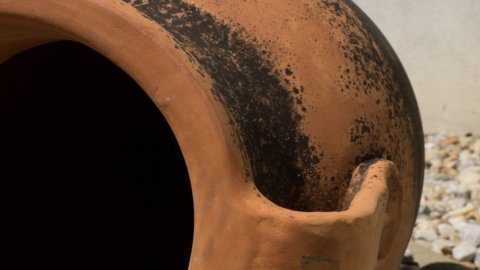Drawing from the past to design the future is not only a way to recover and pay homage to an ancient tradition but also to grasp its innumerable potential. And the future of wine in amphora take with you the rediscovery of ancient flavors and aromas. The custom of transporting and storing wine in amphorae (but also other foods) has distant roots, they arrived with the Greeks but it was the Etruscans who spread them in Italy, then they fell into oblivion and today they are back in the limelight not only for storing wine , but also beer and spirits. This is because the terracotta jars, unlike wood, they do not add tannins and aromas, but faithfully respect the purity and identity of the vines.
The return of wine in amphora is not a fad or a passing phenomenon, but the awareness that this ancient container still demonstrates great oenological modernity and flexibility. An ancient tradition that was the focus of a conference "Wine and amphorae: the return to clay” at the Simei of Unione Italiana Vini a focus that retraced its origins, allowed a comparison between producers, and investigated future commercial prospects and developments.
The history of wine in amphorae
Amphorae have been used since ancient times for storing fermented foods and beverages. A story that dates back to the age of Magna Graecia, when these precious containers were transported from one side of the sea to the other. The homeland of this technique is certainly the Georgia, where the producers have been able to preserve the methods and techniques of producing wine in amphora (qvevri in Georgian) over the centuries, so much so that they have been included by UNESCO in the list of intangible cultural heritage of humanity.
Ma How does winemaking in amphora work? The qvevri are first filled with the grape must and remain underground until the following spring to allow first the spontaneous fermentation and then the refinement of the wines, and this applies to both whites and reds. Then the vinification techniques in amphorae can change according to the local tradition. For example, in some areas maceration on the skins is an essential phase for natural vinification in amphorae, in order to guarantee an absolutely natural treatment.
What are the advantages of storing wine in amphorae? And the difficulties?
Various researches have shown that terracotta does not yield any flavor. Her porosity then, if the amphora is not coated inside with beeswax and is not buried, it causes micro-oxygenation to take place, which is useful for refining the wine.
Another undisputed advantage of this material is thethermal insulation, due both to the terracotta and to the fact that it is generally buried. Because of this, it works better than steel and almost as well as concrete. And then it is a material, which, if well cared for, can last forever, unlike wood which 'runs out' after a few steps and therefore needs to be replaced.
Furthermore, it is highly appreciated for its "green" value.
However, terracotta is a difficult material to manage: delicate and complicated to sanitize. But two are the critical aspects: the vinification in amphora involves the release of minerals, which alters the organoleptic characteristics of the wine, but which can be overcome by using clays as pure as possible; while the high porosity, if on the one hand it is an advantage, on the other it causes wine oxidation, therefore the choice of grape variety is fundamental, for this reason it is better to prefer the production of wines with a good structure and great freshness.
“Wine and amphorae: the return to clay”: the interventions
Attilio Science, university professor of viticulture (in Milan) and well-known international expert in the sector, underlines regarding the long history of terracotta jars: “It was not only the first container, but also one of the first marketing tools for wine, with engravings that represented the trader and the shape that revealed its provenance".
E Robert joseph, observes that "the variety of the grape is crucial for determining the quality of the product", and that therefore "the wines in amphorae are not necessarily organic or sustainable".
For the international editor of Gambero Rosso, Lorenzo Ruggeri, this winemaking technique is experiencing a real boom. “It is a phenomenon with a rosy future, because it exploits a horizontal communication dynamic that involves young producers on one side and young consumers on the other, who respond with interest”.
The Master of Wine also shares this opinion Gabriel Gorelli: “The return to the amphora today represents a novelty destined to grow and establish itself. But it must be remembered that, beyond the marketing, this vinification does not in itself represent a guarantee of pleasantness or style. Producers will have to find a way to differentiate their labels by giving them a subjective and distinctive interpretation”.
In short, wine in amphora is an ancient technique that has been regaining its well-deserved success for some years, but one must know how to master it and know it deeply in order not to fall into gross errors.





